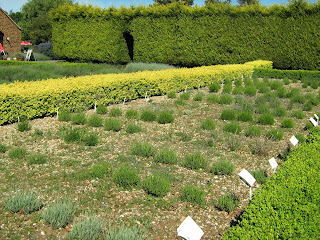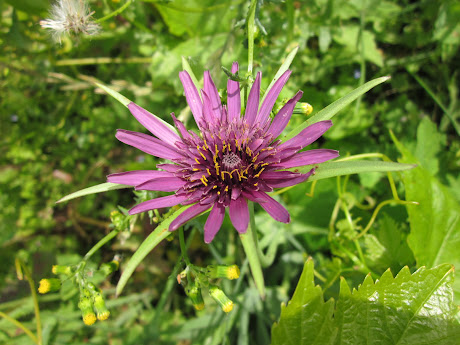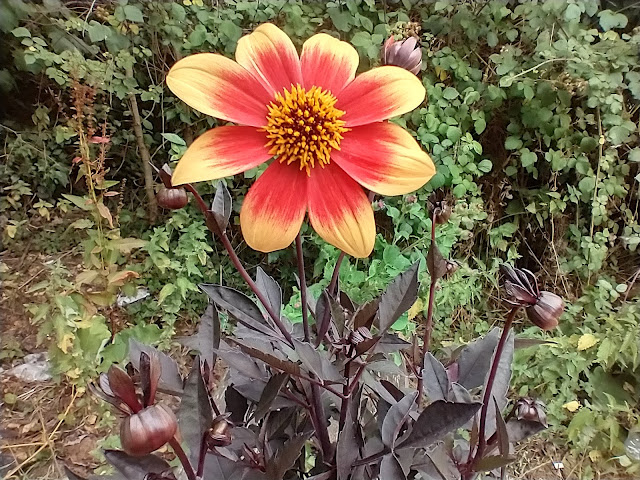Norfolk Lavender
 It's a month since we visited Norfolk Lavender, but it's been in my mind a lot this week because mine is really on song at the moment - that's the visiting bees for you - and the harvest in Norfolk should be well under way by now. At first glance the site looks like a glorified garden centre with its plants sales, shop and cafe, but scratch (and sniff!) beneath the surface and there's much more to discover. Most of the lavender production (both flower and oil distillation) is off-site these days: we visited the historic place where it all began in the 1930s where Linn Chilvers started his successful experiments, not only in finding lavender plants to rival those he'd seen in Provence, but to also distill his own top quality oil.
It's a month since we visited Norfolk Lavender, but it's been in my mind a lot this week because mine is really on song at the moment - that's the visiting bees for you - and the harvest in Norfolk should be well under way by now. At first glance the site looks like a glorified garden centre with its plants sales, shop and cafe, but scratch (and sniff!) beneath the surface and there's much more to discover. Most of the lavender production (both flower and oil distillation) is off-site these days: we visited the historic place where it all began in the 1930s where Linn Chilvers started his successful experiments, not only in finding lavender plants to rival those he'd seen in Provence, but to also distill his own top quality oil.An old lavender perfume recipe was successfully revived and the business grew until today there's around 100 acres of lavender fields under cultivation in Norfolk, including some on the royal estate of Sandringham. The site we visited houses the national collection of lavender (pictured) of 200 cultivars spread mainly across 3 species - Lavandula angustifolia (7 varieties of which are grown for commercial oil production), Lavandula stoechas (which we also call French lavender) and Lavandula x intermedia. The collection itself needs re-accreditation with Plant Heritage because much of it has been replanted this year owing to the poor summers of the past 2 years.
NAH and I took a guided tour - an hour long and well worth doing - especially as we were the only ones on it. This gave us the historical background to the company and an insight into the drying and distillation process. Heaps of harvested flowers are left to dry in a barn, which also has slots in the floor so that warmed air can circulate all the way round. Last year was the first time in memory the lavender had to be turned during the drying process. The flowers from each field are distilled individually for their oil because buyers want particular fields and lavender varieties for their products. Extensive records are kept of a field's harvest and the resultant amount and quality of oil distilled each year.
I was surprised to find out that L. angustifolia can be grown almost indefinitely if it's cut back when in flower - as happens of course with the lavender grown commercially. I want to admire my flowers though, but learnt I can make my plants last a lot longer by cutting them down to about half an inch of green growth in September. I'd just been cutting back the old flower stems, which is why my plants are so woody and need replacing. L. stoechas needs to be cut back in August as it's tender in this country and so needs slightly longer for the plant to harden up after its haircut. A cutback in spring of any cultivar is not recommended for the UK.
During our tour we were given a sample of the dried flowers and the intensity of their scent was fantastic. I kept my sample in the pocket of my shorts and had a delicious whiff every time I took out my hankie during the rest of the holiday. We were also struck by how different the scent can be between both species and cultivars and decided L. 'Imperial Gem' was the best. NAH declared he loathed all L. stoechas but thought L. angustifolia was lovely. Throughout the rest of the holiday he was found sampling and sniffing the scent of lavender plants wherever we went. I might get him to like plants after all!
Naturally our visit ended with a cup of tea at the cafe, where we sampled some lavender cake plus some equally delicious lavender scones topped with strawberry and lavender jam. It was warm enough to sit outside, so we sipped our drinks surrounded by hundreds of honey bees, exploring and drowsling away at the lavender flowers. All in all, a grand afternoon out :)










Thanks for writing about this, something I have always wanted to do visit a lavender farm.
ReplyDeleteI found the notes you made about cutting back the lavender to about one inch of green interesting and I will be trying that on my L. angustifolia - although I cut Lavender back quite hard - I do am not that brutal - think I will test it out on my own before I attack my customers.
:)
K
Hi Karen - it was well worth the visit. I was surprised at how brutal you can be when cutting back as well, but well worth a try. I only told you about what I learnt on the day, but the website has an even more brutal treatment for revitalising very woody plants. I'm going to give that a try with mine before I replace them. I've nothing to lose after all!
ReplyDeleteNB Jekka McVicar also recommends an autumn haircut for lavender, but I don't remember hers being as brutal when I went to her Herb Farm open day last year.
VP ! This was really interesting girl : ) I have a weakness for lavender in my garden and have many of the one named "Provence" .. heaven knows what true cultivar it is but it has single flowers ontop long stems that are very different from my other plants. I'm hoping to collect and dry them for sachets to be made. I am also surprised by a stunning white variety I planted last year .. I wasn't sure if my mind's eye could switch to 'white" for lavender BUT it is amazing .. my favorite for colour and density is Munstead .. next to bright orange butterfly weed it is beautiful : )
ReplyDeleteI loved this post girl ! : )
PS .. here in Canada we can't cut any back in the Autumn .. I have to wait well until late Spring and then it is safe .. poor dears shiver through our winters ? LOL
Interesting post, thanks, particularly the idea of comparing the scent of the cultivars. Have you paid a visit to Somerset Lavender? I went there a few months back after hearing a great talk to our local gardening society by one of the owners. It's a smaller scale operation than Norfolk Lavender, but must be fab at the moment! http://www.somersetlavender.com/default.aspx
ReplyDeleteI love Norfolk Lavender, haven't been for years, but it's not more than an hour away from Tumbledown Farm so I may have to go and refresh my memory!
ReplyDeleteNever had any luck with growing lavender in Wiltshire, but I've put one in the herb border in the veg plot here and it's doing great. I love brushing past it and having the wonderful aroma wafting up to meet me :o)
I'm a terrible insomniac and the one thing that helps me get off to sleep is lavender pillow spray. I really must learn how to make some for myself...
Great post VP.
Oh, we've just got loads of lavender after visting a walled garden (I'll write about it next week - I said that to myself last week and the week before, but definately, I'll write about it THIS week). Fab plant, so many bees gather on it and now I NEED to try and cook with it, you have spirred me on. Just need to get the oven fixed (only been broken a couple of years, ooops).
ReplyDeleteVery interesting to read about how the plant appreciates the trim at the right time. I've grown lavender before and wound up with very woody plants. I'm growing Provence now but they are only smallish this year. Thanks for a great informative post!
ReplyDeleteInteresting post! I like lavender and really must get some planted on the plot. xx
ReplyDeleteFascinating that the scents were different between various kinds of Lavender. I suppose that isn't surprising but lavender is generally so in your face fragrance wise that it is rare to have an opportunity to experience the subtleties.
ReplyDeleteThis must have smelled heavenly! I just planted my first lavender plants this spring, but they aren't growing very fast--is that normal? I will have to check the tags--if I kept them--to see which variety they are.
ReplyDeleteI have finally (!) posted my "Out on the Streets" post if you'd like to take a look. Since I actually live in the country, though, I found myself meandering along some country roads as well.
Interesting tip half an inch of green. I do cut back quite hard sometimes but have let mine get a bit too big and my cuttings are not big enough to replace the plants just yet.
ReplyDeleteHi VP, thanks for all this good advice about lavender trimming. But we really enjoyed hearing about the sniffinf tests! I didn't know there was a difference either. Imagining sipping tea while surrounded by the fragrance and beauty and bees sounds divine.
ReplyDeleteFrances
Joy - 'Provence' sounds like what we call French lavender or Papillon lavender aka Lavadula stoechas. My favourite's 'Hidcote', though I'm contemplating getting some of the 'Imperial Gem' we found. The key to cutting back lavender here is giving it enough time for the new growth to harden before the onset of winter. I suspect that wouldn't happen in Canada and it's also the reason why French lavender needs an August haircut instead of September. It's really hard to do that when they're still flowering though!
ReplyDeleteElaine - welcome and thanks for visiting :) I've put Somerset lavender down on my visiting list - thanks for the info.
RO - I did have a lavender hedge down the front drive at first when we moved here - a lovely way to get to the front door! They seem to do OK in our clay soil here, but I've not cut them back hard enough it would seem...
ReplyDeleteCarrie - the lavender cakes and jam were surprisingly good. It's a lovely plant - I even have some up at the lottie :)
Nikkipolani - you're welcome. I learnt so much from taking that tour, so it's been great to pass some of it on :)
Flighty - I've got a couple of lavender hedges at either end of the plot and the bees love it!
EG - we were surprised it was so. And perhaps in another situation the French lavender would smell good and the English not!
Rose - they're probably spending a little time getting their roots down first. Hopefully by now they're beginning to put on some top growth too. They're a mediterranean plant, so like a warm sunny spot. They don't like the soil to be that rich either - that's why it's surprising they've done so well here in my clay soil. Thanks so much for your OOTS post - I've added it to the round up post already - I'm catching up with my comment backlog here ;)
Joanne - mine are too big and woody too. I fear my cuttings won't be that good either so it's a replacement job for me!
Frances - it was lovely and we're still going around sniffing lavender when we find it!
Interesting comments about the lavender. I am in New Zealand and have a lavender farm (www.lavenderbeds.co.nz). There are between 200 and 300 different lavender and, like roses, they all have their individual perfume. The stoechas varieties (ones with the rabbit ears, sometimes called French, Itallian or Spanish)are ornamental only - horrible smell! 'Provence' is a hybrid, Lanvandula X intermedia Provence. The intermedias you would not usually use for cooking but an American woman (now deceased) called Sharon Shipley has written a lavneder cook book using Provence lavender. Usually you should only use the angustifolia varieties such as Hidcote. To trim lavenders you can do it in the autumn but make sure it's in plenty of time before the frosts come, to harden up. In our experience,if they do get frosted, they will still flower but later. It is the hard pruning from the beginning that will ensure your plant not going too woody. I enjoy learning about lavender farms all over the world and one day!!! I hope to visit lots of them!! Happy lavendering - Ann
ReplyDeleteAnn & Ken - welcome! Thanks so much for adding such great info to this post and comments, especially about the Provence cultivar. We thought L. stoechas was vile smelling too!
ReplyDelete